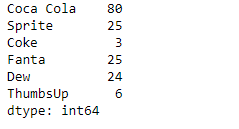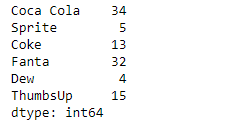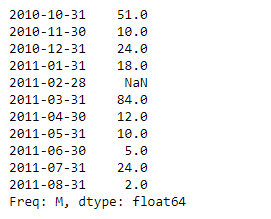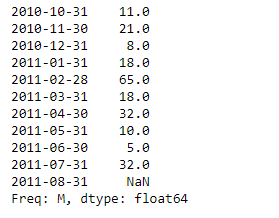Python Pandas Series.corr()
Pandas系列是一个带有轴标签的一维ndarray。标签不需要是唯一的,但必须是一个可散列的类型。该对象支持基于整数和标签的索引,并提供了大量的方法来执行涉及索引的操作。
Pandas Series.corr()函数计算与其他系列的相关性,排除缺失值。
语法: Series.corr(other, method=’pearson’, min_periods=None)
参数:
other:系列
method: {‘Pearson’, ‘Kendall’, ‘Spearman’}或可调用
min_periods :获得有效结果所需的最小观察数
返回 : 相关性 : float
实例#1:使用Series.corr()函数来查找给定系列对象与其他系列的相关性。
# importing pandas as pd
import pandas as pd
# Creating the first Series
sr1 = pd.Series([80, 25, 3, 25, 24, 6])
# Creating the second Series
sr2 = pd.Series([34, 5, 13, 32, 4, 15])
# Create the Index
index_ = ['Coca Cola', 'Sprite', 'Coke', 'Fanta', 'Dew', 'ThumbsUp']
# set the first index
sr1.index = index_
# set the second index
sr2.index = index_
# Print the first series
print(sr1)
# Print the second series
print(sr2)
输出 :


现在我们将使用Series.corr()函数来寻找给定系列对象的基础数据与其他对象之间的相关性。
# find the correlation
result = sr1.corr(sr2)
# Print the result
print(result)
输出 :

正如我们在输出中看到的,Series.corr()函数已经成功地返回了给定系列对象的基础数据之间的相关性。
例子#2 :使用Series.corr()函数来查找给定系列对象与其他对象的相关性。该系列对象包含一些缺失的值。
# importing pandas as pd
import pandas as pd
# Creating the first Series
sr1 = pd.Series([51, 10, 24, 18, None, 84, 12, 10, 5, 24, 2])
# Creating the second Series
sr2 = pd.Series([11, 21, 8, 18, 65, 18, 32, 10, 5, 32, None])
# Create the Index
index_ = pd.date_range('2010-10-09', periods = 11, freq ='M')
# set the first index
sr1.index = index_
# set the second index
sr2.index = index_
# Print the first series
print(sr1)
# Print the second series
print(sr2)
输出 :


现在我们将使用Series.corr()函数来寻找给定系列对象的基础数据与其他对象之间的相关性。
# find the correlation
result = sr1.corr(sr2)
# Print the result
print(result)
输出 :

正如我们在输出中看到的,Series.corr()函数已经成功地返回了给定系列对象的基础数据之间的相关性。在计算对象之间的相关性时,缺失值被跳过。
 极客教程
极客教程